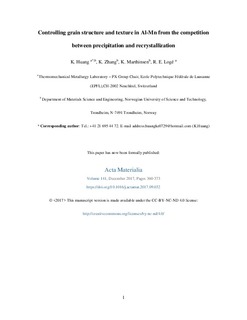| dc.contributor.author | Huang, Ke | |
| dc.contributor.author | Zhang, Kai | |
| dc.contributor.author | Marthinsen, Knut | |
| dc.contributor.author | Loge, RE | |
| dc.date.accessioned | 2017-11-16T08:17:31Z | |
| dc.date.available | 2017-11-16T08:17:31Z | |
| dc.date.created | 2017-10-31T15:49:14Z | |
| dc.date.issued | 2017 | |
| dc.identifier.citation | Acta Materialia. 2017, 141 360-373. | nb_NO |
| dc.identifier.issn | 1359-6454 | |
| dc.identifier.uri | http://hdl.handle.net/11250/2466558 | |
| dc.description.abstract | The recrystallization behaviour of Al-Mn alloys (AA3xxx series alloys) is affected by randomly distributed dispersoids present before annealing, by dispersoids precipitated at grain/subgrain boundaries before the onset of recrystallization, and by dispersoids concurrently precipitated during recrystallization. In this study, the effects of these three populations of dispersoids on the recrystallization behaviour of a cold rolled AA3xxx alloy were analysed and compared using four temperature-time paths to different target temperatures. Changing the temperature-time path modifies the extent of recovery, the dispersoid structures, as well as the absolute recrystallization temperature, which then influences the final grain structure and recrystallization texture. In particular, an in-depth investigation on how different populations of dispersoids affect the main recrystallization texture components of AA3xxx alloys, i.e., P{011}〈566〉, ND-Cube {001}〈310〉, and Cube {001}〈100〉, has been carried out. The results clearly show that, as compared to isothermal annealing, annealing with more elaborate heating and annealing schedules (temperature-time paths) all lead to increased strength of the P texture component and decreased intensities of both the Cube and ND-rotated Cube texture components. The increase of P texture strength and average grain size is most significant when recrystallization occurs concurrently with precipitation. The controlling mechanisms behind this behaviour and the possibility to use them to tailor the grain structure and texture of similar alloys are further discussed. | nb_NO |
| dc.language.iso | eng | nb_NO |
| dc.publisher | Elsevier | nb_NO |
| dc.rights | Attribution-NonCommercial-NoDerivatives 4.0 Internasjonal | * |
| dc.rights.uri | http://creativecommons.org/licenses/by-nc-nd/4.0/deed.no | * |
| dc.title | Controlling grain structure and texture in Al-Mn from the competition between precipitation and recrystallization | nb_NO |
| dc.type | Journal article | nb_NO |
| dc.type | Peer reviewed | nb_NO |
| dc.description.version | acceptedVersion | nb_NO |
| dc.source.pagenumber | 360-373 | nb_NO |
| dc.source.volume | 141 | nb_NO |
| dc.source.journal | Acta Materialia | nb_NO |
| dc.identifier.doi | 10.1016/j.actamat.2017.09.032 | |
| dc.identifier.cristin | 1509464 | |
| dc.description.localcode | © 2017. This is the authors’ accepted and refereed manuscript to the article. LOCKED until 17.9.2019 due to copyright restrictions. This manuscript version is made available under the CC-BY-NC-ND 4.0 license http://creativecommons.org/licenses/by-nc-nd/4.0/ | nb_NO |
| cristin.unitcode | 194,66,35,0 | |
| cristin.unitname | Institutt for materialteknologi | |
| cristin.ispublished | true | |
| cristin.fulltext | preprint | |
| cristin.qualitycode | 2 | |

